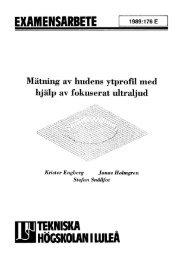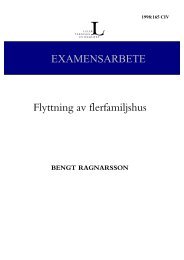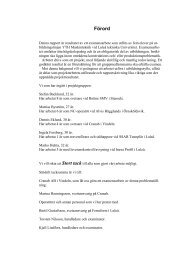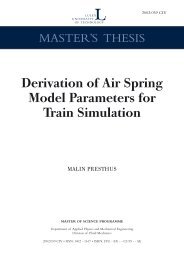LICENTIATE THESIS - Luleå tekniska universitet
LICENTIATE THESIS - Luleå tekniska universitet
LICENTIATE THESIS - Luleå tekniska universitet
You also want an ePaper? Increase the reach of your titles
YUMPU automatically turns print PDFs into web optimized ePapers that Google loves.
CONCRETE STRENGTH DEVELOPMENT IN SWEDISH<br />
BRIDGES<br />
by Håkan Thun, Lennart Elfgren and Ulf Ohlsson<br />
ABSTRACT<br />
In the paper the development of tensile and compression strength is presented for old<br />
concrete railway trough bridges. The compression strength has usually increased 50 to<br />
100% over the years for these trough bridges. However the same could not be said for<br />
the tensile strength. When the results from drilled out cores were compared for<br />
differrent structural parts, i.e. the slab and the longitudinal beams, it turned out for one<br />
bridge that the compressive strength was approximately 15% higher in the longitudinal<br />
beam than in the slab. This indicates that there is a difference in strength between the<br />
side beams and the slab. Until this difference is verified with further studies, a reduction<br />
of the concrete strength with 15% has been proposed when the tests are done in the<br />
side beam and the analysis concerns the slab.<br />
In the paper a rather well-known method, the Capo-test, is used to determine the insitu<br />
concrete compression strength in old railway trough bridges. The Capo-test has<br />
been compared with the results from drilled cores, which is the common way to<br />
determine the in-situ strength of a concrete structure. The study indicates that the<br />
Capo-test can be used on objects with old age, but with some restrictions, especially<br />
regarding the aggregate size. Results from tests performed on the Lautajokki Bridge in<br />
Northern Sweden show that the Capo-test might in some cases overestimate the<br />
compressive strength. An improved formula is presented for evaluation of the<br />
compression strength from Capo tests. It gives a better correlation than the general one<br />
and the one proposed by Rockström & Molin (1989) for old structures, but it might<br />
give results on the unsafe side and further studies are necessary.<br />
Keywords: strength development, Capo-test, drilled cores, concrete, bridges<br />
RESEARCH SIGNIFICANCE<br />
During the last decades it has become more and more important to assess, maintain and<br />
strengthen structures like bridges, dams and buildings due to increased age of many<br />
structures and the high costs to construct new infrastructure. Therefore it is of great<br />
interest to find methods to evaluate the concrete strength. In this paper a rather wellknown<br />
method, the Capo-test, is used to determine the in-situ concrete compression<br />
strength in old railway trough bridges. Up to this date the method has primarily been<br />
used to estimate the strength of the cover-layer of new structures. The Capo-test has<br />
been compared with the results from drilled cores, which is the common way to<br />
- 1 -







